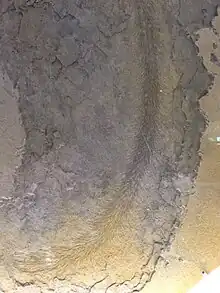William Baragwanath
William Baragwanath (1878–1966) was an Australian surveyor, geologist and public servant.[1] In 1922, he was appointed director of the Geological Survey of Victoria, and in 1932 Secretary for Mines. He discovered fossils of Baragwanathia, a genus of extinct plants named in his honour, which at the time was the most ancient land plant known. He was exceptionally knowledgeable about the geology of the Australian state of Victoria.[1]
William Baragwanath | |
|---|---|
 Baragwanathia fossil | |
| Born | 1 August 1878 |
| Died | 20 September 1966 (aged 88) Prahran, Victoria, Australia |
| Nationality | Australian |
| Occupation | Geologist |
Baragwanath married Clara Ethel, née Jones, on 9 May 1900 at a Presbyterian Church in Flemington. Together they had nine children; seven girls and two boys. He earned his degree at the Ballarat School of Mines.[1]
References
- Talent, John A. (1979). "Baragwanath, William (1878–1966)". Australian Dictionary of Biography. National Centre of Biography, Australian National University. ISSN 1833-7538. Retrieved 31 January 2012.
This article is issued from Wikipedia. The text is licensed under Creative Commons - Attribution - Sharealike. Additional terms may apply for the media files.